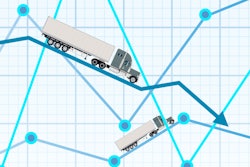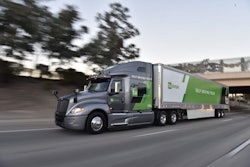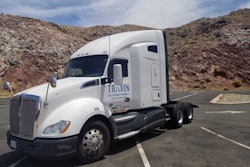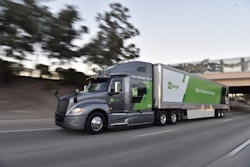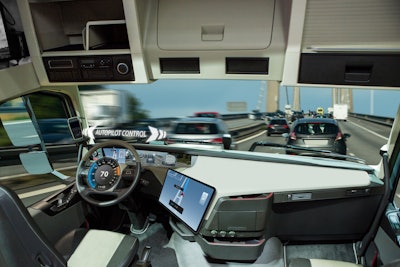 "These are exciting times for trucking. I’m excited for the benefits autonomous trucking will provide for both our industry and the society we serve," writes Richard Stocking, CEO and principal at DPX Consulting. Below, he details the changes he envisions looming for the industry and society when autonomous trucks become commercialized.
"These are exciting times for trucking. I’m excited for the benefits autonomous trucking will provide for both our industry and the society we serve," writes Richard Stocking, CEO and principal at DPX Consulting. Below, he details the changes he envisions looming for the industry and society when autonomous trucks become commercialized.
Engineers have been working on autonomous trucks for years, but most people have never seen one.
But make no mistake: Big changes are coming to trucking. Autonomous trucks are making progress towards moving away from controlled test environments and into the real world. This will have a huge impact on our industry, and it’s time to embrace that impact and begin adjusting our mental models – and our business models.
As Benjamin Franklin said, “When you’re finished changing, you’re finished.” Instead of clinging to the past, we need to lean into the future.
Autonomous technology is evolving quickly. In May 2015, I participated in the world premiere of the Freightliner Inspiration as it drove across the Hoover Dam. This was the first licensed autonomous truck to operate on an open public highway in the United States. As I rode in that truck, I remember thinking about how the changes in trucking over the past 35 years since deregulation will pale in comparison to what we see in the next 35 years.
Last month, Embark, Kodiak, and TuSimple became the first three autonomous truck companies to join The Self-Driving Coalition. These companies have raised hundreds of millions of dollars and have been working for the past several years now with dozens of trucks running millions of miles. In addition to these three companies, there are many other independent companies and OEMs working on their own programs.
I believe it will be many years before we have fully autonomous trucks going from shippers’ docks to consignees’ docks. However, I’m convinced this year we will begin to see more autonomous trucks running the “middle miles” from on-ramp to off-ramp on certain freeways where the terrain and weather are especially favorable. As they begin to gain real-world experience, we’ll begin to see these trucks operating on more and more sections of freeways.
I’m excited by the many benefits autonomous trucks will have for our industry and the society we serve. Here are a few I see:
Better Safety. Experts believe autonomous trucks will have significantly fewer preventable crashes and fatalities per million miles than non-autonomous trucks running on the same roads. Analysts also believe autonomous trucks will negate the effects of the small percentage of trucks with drivers who are drowsy, distracted, or texting while driving. Autonomous trucks can be strictly regulated to always maintain an appropriate following distance and to never exceed speed limits. Autonomous trucks will have all the latest safety technology and equipment and will be inspected frequently by professionals.
Fewer Emissions. I believe these trucks will help our industry reduce our carbon footprint. With the latest technology, they will already be among the cleanest diesel trucks on the road. They will emit even fewer emissions than existing trucks because they have no need to idle and will be optimized to change gears and accelerate and decelerate in the most fuel-efficient manner. There is a possibility that platooning could open the door to further improvements in fuel economy. Additionally, since these trucks will be operating in a specific environment, the engine, transmission, and tire specs can be optimized accordingly. Finally, the most exciting opportunity for emissions improvements comes from the way the hub and spoke networks of these trucks will increase the opportunity to deploy short range electric trucks to conduct local drayage between hub and shipper dock.
Less traffic. Autonomous trucks will reduce congestion on our roads. By running these trucks 24/7, we will begin replacing miles run during the day during times of peak congestion with miles run during periods of less congestion.
More trade. As the cost of transportation decreases (due to autonomous trucks), trade could increase. This increase in trade could make it easier for more people to have access to more goods at lower prices. Increased trade could also make it easier to bring more jobs to more locations.
For trucking specifically, the autonomous revolution could mean:
More local Driving Jobs. There will be a significant increase in the number of local driving jobs hauling trailers from shippers to the autonomous drop lots, and from the autonomous drop lots to consignees.
Better jobs. These local driving jobs will allow drivers to be home every day! Also, the turnover in these jobs should be exponentially lower and allow carriers to spend more money on driver wages and less money on turnover.
More diverse driver base. With more local driving jobs, we’ll see more interest from millennials, women, and military veterans. Drivers can stay close to family with predictable work schedules and predictable paychecks.
Faster long-haul service. Autonomous trucks will operate continuously on long-haul routes beyond hours of service. Goods currently moved via truck will get to their destinations faster with less spoilage, and additional demand could shift from air freight to autonomous trucks, which would be dramatically cheaper and create fewer emissions compared to planes.
More trailers, fewer tractors. The on-ramp-to-off-ramp model of autonomous trucks will drive demand for more trailers while simultaneously reducing the number of trucks running middle-miles.
More drop yards near freeways. We will need many more drop yards near freeways where the autonomous trucks can safely enter and exit the freeway.
More parking For truckers. Autonomous trucks will have no need to stop at rest stations and truck stops, freeing up space for truckers who do.
Lower middle-mile costs. Autonomous trucks will lower the cost of transportation. Driver wages and benefits are only some of the savings. There will also be significant savings in fuel and safety.
Improved Revenue/Utilization. Class 8 trucks typically average around 100k miles per year, whereas autonomous trucks could average 300k+ miles per year. This means you could achieve 3x as much revenue per truck!
Lower first and final mile costs. With local trucks running the first and final miles, carriers should also see reductions in costs as they use daycabs rather than sleepers, slip-seat trucks, and are able to use alternative fuels. There should also be a dramatic decrease in turnover, which will almost certainly lead to better, safer drivers.
New business models. Hub-and-spoke models should increase. Independent companies could begin providing trailers the same way independent companies provide containers for shipping by railroad and boat.
In short, embrace change! Lean into it.
These are exciting times for trucking. I’m excited for the benefits autonomous trucking will provide for both our industry and the society we serve. I encourage everyone to pay attention and study up on these companies and their technologies. We not only need to adapt to these changes, but to embrace and lean into them.
Richard Stocking is the founder and CEO of DPX Consulting, a transportation consulting firm that helps fleets with strategic operational improvements and M&A activity. Prior to founding DPX Consulting, he enjoyed a 27-year career with Swift Transportation that began as an entry-level customer service representative and worked through various roles in sales and operations throughout the United States before becoming president and CEO. At the time of his departure, Swift Transportation had grown into the largest truckload carrier in North America with 18,000 trucks, 60,000 trailers, and $4.5 billion in annual revenues servicing the US, Mexico and Canada.



